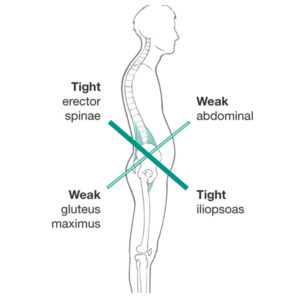
Do you want to reduce low back pain? Have you ever heard of Lower Crossed Syndrome?
We have mentioned in other articles that individual muscle syndromes do not occur in isolation very often. So, you might find it helpful to see related muscles in context.
Lower Crossed Syndrome (LCS) is one way to think about common patterns of muscle dysfunction and imbalance that underlie much of the chronic low back pain that we see.
First, the normal balance of muscles between the front and back of the hip girdle is disrupted. Then the muscles that are too weak or too tight to do their job destabilize the entire lower and mid-back, hips and legs. When muscles are constantly shortened or lengthened in relation to each other, these imbalances can occur. Certain patterns of muscle weakness and tightness that cross between the front and the back sides of the body are the typical pattern of Lower Crossed Syndrome.
Specifically, the hip flexors and lumbar extensors are constantly engaged and are too tight. In addition, the deep abdominal muscles on the front side and the glutes on the back side are weak. This imbalance causes an anterior tilt of the pelvis, increased flexion of the hips, and a compensating curve in the lumbar spine. Further, the hamstrings are often tight in this syndrome as well.
Lower Crossed Syndrome is often a major factor in low back pain and hip pain. However, imbalances in the hip tend to drive problems down through the legs and feet. That means that some aspects of LCS can also contribute to foot, ankle and knee problems too.
In a word, Lower Crossed Syndrome and Chronic Pain is about posture. Posture is the way in which we unconsciously hold our bodies, both at rest and in motion.
Over time, holding our lower body in positions that are incorrect leads to significant distortions in our posture. It can become difficult or impossible to simply, ‘stand up straight’ or ‘stop slouching’. We need a real method. The patterns of Lower Crossed Syndrome help us devise a better approach.
For instance, if our hip flexors are too tight we cannot extend our leg fully at the thigh. This can lead to a ‘duck footed’ gait and chronic low back pain and hip pain. We can’t just decide to walk differently.
An important part of successful treatment is releasing our hip flexors. We know tight hip flexors alone cause low back pain. This includes targeted compression of these muscles, stretching and moving the thigh through the full range of motion at the hip.
But supple hip flexors won’t help much if our glutes don’t actively pull our leg into extension. Weakness or inhibition of the glutes is treated with targeted compression and muscle activation techniques followed by vigorous strengthening exercises.
Weak glutes probably caused us to engage our hamstrings or our spinal erectors. This causes those muscles to shorten and leads directly to low back pain.
Finally, a weak transversus abdominis is unable to stiffen the abdomen to support your back. This makes our hip flexors, spinal erectors and other muscles work harder.
Types of Lower Crossed Syndrome
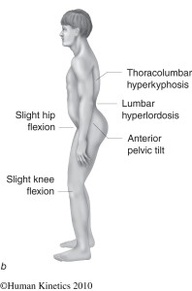 Vladimir Janda, who first coined this term, divided LCS into two categories, Type A and Type B. The two types are similar and display the same main muscle imbalance characteristics. However, successful treatment of lower crossed syndrome requires understanding the more subtle differences.
Vladimir Janda, who first coined this term, divided LCS into two categories, Type A and Type B. The two types are similar and display the same main muscle imbalance characteristics. However, successful treatment of lower crossed syndrome requires understanding the more subtle differences.
Type A is chiefly due to the shortness of the hip flexors leading to a deeper, shorter lower spinal curve (lordosis). It does not extend into the mid-back region. Consequently, this causes chronic hip flexion and also typically leads to knee flexion.
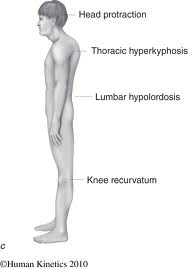 In contrast, Type B is primarily due to weakness and length of the abdominal wall giving a shallower, longer spinal curve (when compared to Type A) which extends into the mid-back area. In addition, the head is more forward, with anterior pelvic tilt, and hyperextension of the knees.
In contrast, Type B is primarily due to weakness and length of the abdominal wall giving a shallower, longer spinal curve (when compared to Type A) which extends into the mid-back area. In addition, the head is more forward, with anterior pelvic tilt, and hyperextension of the knees.
If we took a photo of you from the side in an unguarded moment, which one looks more like you? Of course, assessment is not quite that simple, but this view is a good starting point. Note than the drawings show a thin person. These patterns can develop in any body shape or type.
Basic Anatomy
Anatomical details can be found in the links for individual muscles below.
Lower Crossed Syndrome involves weakness of the glute muscles and abdominal group. The glutes include gluteus maximus, gluteus medius and gluteus minimus. They get progressively smaller and deeper. The ab group includes transversus abdominis (your internal weight belt), rectus abdominus (the six pack muscle) and internal and external obliques, These muscles are inhibited and substituted by activation of other muscles.
At the same time, the hip flexors and extensors the low and mid back are tight and engaged too much. This includes: Iliopsoas and TFL (tensor fascia latae), spinal erectors, the multifidi, quadratus lumborum and latissimus dorsi.
The hamstrings tighten to compensate for anterior pelvic tilt and an inhibited gluteus maximus.
Fixing Lower Crossed Syndrome
So how do we fix it? There are three components to beginning almost any lower body postural correction and reducing pain:
First, begin a regular program of diaphragmatic breathing. Reduce chest breathing and learn abdominal bracing techniques.
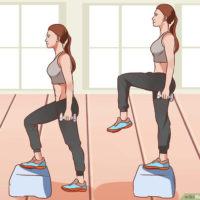 Next, strengthen the gluteus maximus. For example, try double and single leg glute bridges, weighted low lunges or step-ups with weights. In addition, you should strengthen gluteus medius with a clamshell exercise and upper corner kickout. Note that we do NOT recommend squats and dead lifts in most cases. Most people cannot achieve the necessary form without coaching. More importantly, these exercises engage the spinal erectors and hip flexors, which are too tight anyway.
Next, strengthen the gluteus maximus. For example, try double and single leg glute bridges, weighted low lunges or step-ups with weights. In addition, you should strengthen gluteus medius with a clamshell exercise and upper corner kickout. Note that we do NOT recommend squats and dead lifts in most cases. Most people cannot achieve the necessary form without coaching. More importantly, these exercises engage the spinal erectors and hip flexors, which are too tight anyway.
Click here for glute self-care details.
Finally, lengthen the hip flexors. For instance, a low lunge, warrior I pose and passive psoas release are all examples of psoas stretches. However to make the most of them, you should self-compress the psoas first. Think of your psoas as your “upper” hip flexor.
Click here for more information on psoas self-care.
Beyond this, you should consider tightness of rectus femoris (one your quads) that is the other major hip flexor. This of this muscle as your “lower” hip flexor.
Click here for more information rectus femoris self-care.
If you are more of a “Type A”, your spinal erectors are probably quite tight. There are several muscles in this group but much of the same advice applies to most of them. After appropriate self compression, consider gentle forward bends, child’s pose or a reclining, rocking knees to chest pose.
Click here for information on longissimus and multifidi self-care.
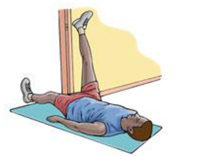 Finally, your hamstrings are probably quite tight. This is really more of a symptom of tight hip flexors than an underlying cause. However, tight hamstrings further reduce mobility of the hips. They correlate with low back pain and disc injuries. We prefer passive hamstring stretches such as this.
Finally, your hamstrings are probably quite tight. This is really more of a symptom of tight hip flexors than an underlying cause. However, tight hamstrings further reduce mobility of the hips. They correlate with low back pain and disc injuries. We prefer passive hamstring stretches such as this.
If you are more of a “Type B”, your abs and your upper body posture are bigger part of the picture. Because of this, you should strengthen your neck flexors to reduce head forward posture and rounding shoulders.
Abdominal work should be done with caution because activation of trigger points in the rectus abdominis. This can cause additional low back pain. Avoid sit-ups and ab crunches. In addition to the the breathing exercises above, ab work can begin safely with abdominal roll backs and progress from there.
Conclusion
Of course, reducing strain and increasing strength in the right places relieves pain. It is a simple concept and it works. We continue to use and improve ways to use this perspective to treat lower back and hip pain with great success.
Janet was great. FANTASTIC person who knew how to treat and deal with my conditions. Very informative. Finally someone who knew what I was talking about.
Really Good
It was interesting, and helpful for my IT band and hip
My experience was wonderful. Janet was very kind and attentive. I felt great after my session and would recommend to try it out.
The lady that assisted me was awesome! I suffer from fibromyalgia and when I left I felt like a brand new person! I plan to return when I get time!
Janet was great – knowledgeable and she found all my “hot spots.”
Seriously, if you are looking for massage therapy that actually does your body good–that changes its function for the better and actually makes pain go away–then this is the place you need to come. Not Massage Envy. Not a chiropractor. You need trigger point from knowledgeable experts in the craft.
If your have pain in any part of your body this is the place to go. It focus on the muscles where the pain is. you will feel like a new person. Awesome will be returning. Thanks nice friendly and attentive
amazing!!!
I felt so much better after my appointment. Thank you and thanks for the self care tips!
Experienced therapist. Feel great after appointment…
Highly recommended!
What a great experience. The provider was able to recommend things I can do to improve my pain. Address issues I didn’t even share with her that she was able to tell just by her exam and treating me for what i went for. Will be back. Feeling grateful
I spent so much money on chiropractors. This is much better. Everybody should try it out.
Beautiful, relaxing setting. Therapist was knowledgable and professional. I’ll be going back. Thank you.
Janet is very informative. I loved that she explained which muscles/groups she was working on. I learned a lot about my posture and why some of my muscles are not activating. She also provided me with a list of considerations and excercises to improve my posture. I will be back!
Janet has a unique gift and talent in trigger point therapy. I’m definitely seeing her again!
Of course, everyone is different and many of us have additional challenges and complications. Naturally, we tailor our treatment plans to the individual, but there are common foundations to this work with everyone.
If you are having similar issues, you may find that a just few treatment sessions helps! We will identify and treat root causes of your individual case. We also offer professional treatment modalities and techniques in a professional setting.
All treatment is performed by licensed professionals with additional training and certifications in advanced techniques. This includes trigger point therapy, fascial stretching, neuromuscular and movement therapy, kinesio taping, myofascial release, cupping, acoustic compression, self-care classes and more. We often combine several of these techniques into a single session..
No one wants chronic pain! We can work together with you to help sort out the issues.
Click here or all us at 630-858-0000 today to make an appointment!
If reading from a pdf or printout, you may use this QR code to view the entire article on your phone with complete with links and videos: 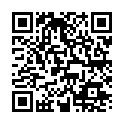
https://WestSubPainRelief.com/treatment-lower-crossed-syndrome
